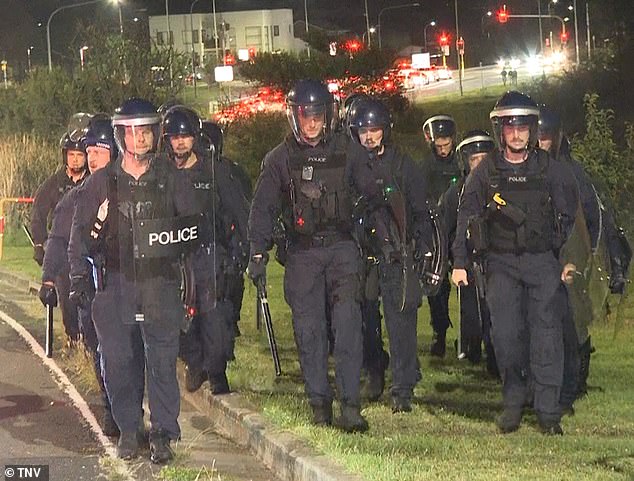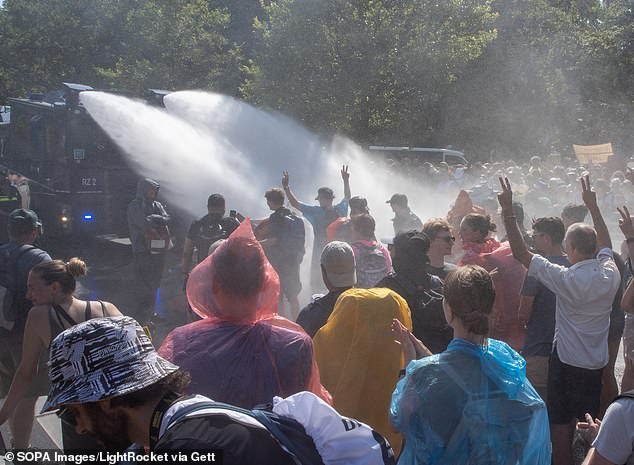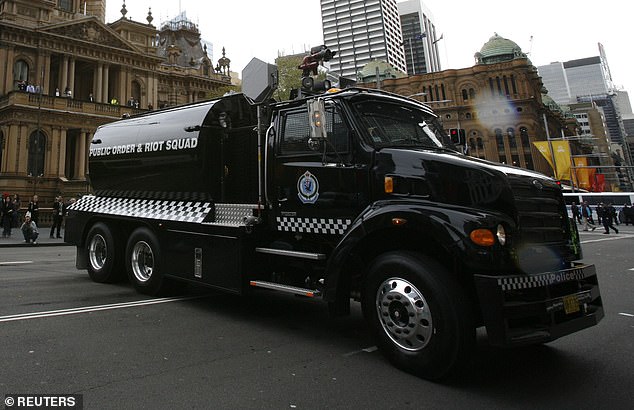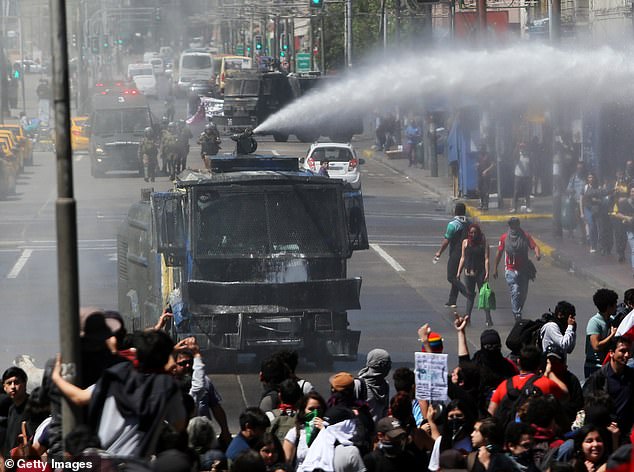EXCLUSIVE
Police have given away a $700,000 water cannon that was purchased to counter violent public unrest such as this week’s riot at Wakeley Church in Sydney’s western suburbs.
The water cannon was purchased in the wake of riots in Redfern in 2004 and Cronulla and Macquarie Fields in 2005, during a political era of tough talk about fighting crime.
The device was intended to be used in the most serious incidents of public disorder, but was handed over to NSW Fire and Rescue five years ago and had never been used to quell a riot.
A mob of around 2,000 angry men were involved in a series of intense clashes with police in Wakeley, near Fairfield, on Monday night.
Police have given away a $700,000 water cannon that was purchased to counter violent public unrest such as this week’s riots in Wakeley, in Sydney’s western suburbs. (File image of a water cannon)

An angry mob of thousands were involved in a series of intense clashes with police in Wakeley, near Fairfield, on Monday night. The agents are photographed at the scene.
The riot was sparked when a 16-year-old boy allegedly stabbed Bishop Mar Mari Emmanuel during a live-streamed sermon at Christ the Good Shepherd Church.
The alleged murderer was captured by members of the congregation before the police arrived.
Parishioners took to the streets and surrounded the church from approximately 7 p.m. until after midnight.
Police set up a helicopter and sent more than 100 officers, including members of the Tactical Operations Unit and the Public Order and Riot Squad.
Rioters threw bricks at police officers and smashed the windows of several police cars. More than 50 officers were injured and several were taken to hospital.
Water cannons have been widely used for riot control in other parts of the world, including the United States, South Africa, parts of Europe including Germany, and Asia.

New South Wales Police purchased a water cannon in the wake of riots in Redfern in 2004 and Cronulla and Macquarie Fields in 2005. (File image of a water cannon)
The New South Wales government bought an American-built water cannon 16 years ago for use by police, but the only time it was seen fired was during a media event.
The roof-mounted high-pressure cannon was mounted on a truck with a 12,000-liter tank and could shoot a torrent of water more than 50 meters.
The vehicle was equipped with an airtight cabin to protect its occupants from smoke and gas and with unbreakable “anti-bandit” glass reinforced with metal mesh.
A heavy push bar mounted on the front of the black truck allowed it to overcome barricades and other obstacles.
Last month, Chris Rath, a member of the NSW Liberal upper house, sought a response from the government about the whereabouts of the device.
‘Do the NSW Police still have a water cannon?’ Mr. Rath asked.
On April 11 they told him: ‘No. In 2019, a water cannon that previously belonged to the New South Wales Police Force was donated to NSW Fire and Rescue.

The New South Wales government purchased an American-built water cannon for use by police 16 years ago, but the only time it was seen fired was during a media event.
When the possibility of purchasing a water cannon arose after the Macquarie Fields riots, Police Commissioner Ken Moroney was not very enthusiastic about the idea.
“When we get to the stage of having water cannons… in that sense, we have really lost our way,” he said.
Labor Prime Minister Morris Iemma announced in March 2006, three months after the Cronulla race riots, that a tender would be called for a water cannon to be used by the Public Order and Riot Squad.
“Water cannons are used very effectively to disperse riots and civil unrest in Europe, the Middle East and Indonesia,” Mr Iemma said at the time.
“We have never used one before in New South Wales, but recent events have shown we need to be prepared for large-scale public disturbances.”
The cannon was publicly displayed in Homebush Bay for the first time two weeks before the September 2007 Asia-Pacific Economic Cooperation (APEC) summit.
At that demonstration, the cannon knocked down 120kg poles for television cameras and newspaper photographers.
“Attention, attention, if you do not disperse, they will fire the water cannon at you,” said a voice from inside the vehicle before the hose was deployed.
‘Warning, warning, warning, a water cannon will be fired. Start, start, start.’
After that display, Iemma dismissed the acquisition of the cannon as a stunt and admitted it could cause “serious injuries” if used against a crowd.
“I hope we never have to use equipment like this,” he said.
“But if the situation arises, if there are going to be people taking the law into their own hands with wanton behavior on our streets, then this is a good weapon to restore order and control.”
The commander of the Public Order and Riot Squad, Superintendent Steve Cullen, said he had stood in front of the cannon to experience its force for himself and had not been injured.
“In my opinion, it is an appropriate piece of equipment, and it looks intimidating and it should be, because it is one of the tactical options that we should bring to APEC,” he told reporters.
An agreement was reached between the New South Wales Police Association and the government that the cannon would never be fired at strikers during industrial protests.
WhatsNew2Day Australia understands the police never considered the device suitable for responding to riots.
As of 2011, the cannon had not yet been used, but Liberal Police Minister Mike Gallacher said the force would not discharge it.
“This government will retain these resources since now that they have been purchased it makes economic sense to have them available when they are needed,” he said.
At that time, the device cost $3,000 a year to maintain and depreciated 10 percent annually.
Greens MP David Shoebridge had said the police budget would be better spent on training than on “a few big toys that barely come out of their packaging”.

